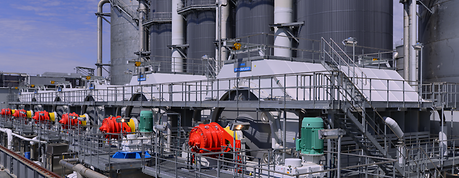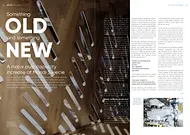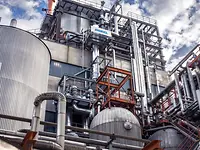Maintenance, upgrades, optimization, spare parts, wear parts
Something OLD and something NEW - A major pulp capacity increase at Mondi Swiecie
Mondi Swiecie’s integrated mill in Poland needed to increase its pulp capacity by 25% to meet growing demand from its five five paper machines using virgin fiber. The solution was a complex but hugely successful combination of utilizing older equipment at the same time as installing new, state-of-the-art technology from ANDRITZ.

Wojciech Jazdziewski (left) and the ANDRITZ team (Jouni Pekonen, Mikko Haapsaari, Aki Muhli, and Tomi Suikki) on the top of the digester.
Mondi Swiecie is one of the largest integrated pulp and paper producers in Poland. The mill produces some 500,000 t/a of pulp for consumption on five of its six paper machines – the sixth machine, PM 4, produces paper from 100% recovered material. In total, the mill produces 1.5 million t/a of a mixture of corrugated board, kraftliner, and sack papers.
Mondi Swiecie contacted ANDRITZ in 2012 to discuss its intention to increase kraft pulping capacity by 100,000 t/a with the ultimate aim of producing more virgin-based grades on two recently rebuilt paper machines. The management at the mill had a deep understanding of the underlying potential at the site when they estimated that two old parallel fiberlines, originally installed in 1972, still had room for a major capacity increase.
Marcin Bocian, Mondi Swiecie’s Pulp Manager, explains, “As part of our Green Project at the mill, our target was to increase the capacity of the digesters by a further 150 tonnes per day to reach 750 tonnes per day of pulp from each digester. Of course, we needed to achieve this without any negative impact on pulp quality. We also wanted to increase the freeness and stability of the kappa number at the same time as reducing alkali losses.
“Before the project we were running up to 650 tonnes per day of good quality pulp, but everything was overloaded, including the digesters and washing lines. “The digesters are over 40 years old, and they were originally designed for just 250 t/d, so we were already pushing the limits.”

Diamondback™ chip bin bottom and chip metering screw provide uniform chip flow.
REPAIR, UPGRADE, OR REPLACE?
In the Mondi Swiecie case, it turned out that the best solution was a mixture of upgrading and replacing old technology with new. In the cooking area, the main focus was to upgrade the existing main equipment and to add new auxiliary equipment, such as heat exchangers, to provide the needed capacity and conditions for the future capacity. On the other hand, in the washing area the most economical solution turned out to be a third line so that each of the lines would handle 500 t/d production.
Compared to a green field project, the prework prior to the investment decision was the key to a successful project. The proper understanding of equipment performance and existing bottlenecks required detailed analysis including comparing the current results to estimated equipment performance. ANDRITZ performed an audit in co-operation with mill people at Swiecie in 2014 to get a full understanding of the possibilities to achieve the set targets.
The mill’s daily laboratory data and DCS data were used for the analysis and calculations of the existing conditions. The digester and washing area were modelled and simulated using simulation programs. By modelling the existing situation and predicting the potential, the following parameters were collected as the basis for the simulations:
- Physical size and design of the digester area
- All flows
- All temperatures
- All available wood and pulp parameters
In the simulation of the situation inside the digester, the following were considered:
- Chip column compaction
- Friction forces of liquor and chip flows
- Kappa, alkali, and temperature profiles
The main objective of this simulation was to assess how closely the theoretical model reflected the actual operation and could accurately predict changes in the digester conditions as the chips moved through the vessel.
Besides the full understanding of the process, the mechanical condition of equipment was the second important key in evaluating the needed changes and total budget. The Swiecie mill provided excellent equipment lists to ANDRITZ, including a comprehensive evaluation about the condition and usability of each piece of equipment.
Mondi Swiecie’s Pulp Production Engineer, Wojciech Jazdziewski, says, “We were very impressed by how deeply ANDRITZ experts and engineers studied our existing situation for this project. They were not simply looking to provide a mechanical solution, for instance, bigger pumps or larger areas of screens. They dug really deep, addressing the pulp quality, as well as taking into account further capacity increases in the future.”
Aki Muhli, ANDRITZ Technical Specialist and Process Engineer for the Swiecie project, says, “There is no doubt that the mill was pushing the limits with the digesters and washing lines, and we looked closely at how best to approach the challenge and to get the most out of it. During the sales and engineering phase, we looked at the different options, and we visited a couple of references in Finland with the Swiecie team to see what best solution would fit.”
MAIN TECHNOLOGICAL IMPROVEMENTS
The audit results confirmed that the main focus areas related to the capacity increase were chip pre-steaming and digester internal upgrades to improve chip flow and washing. Channeling phenomena in the silos caused variations in turpentine cooling and pre-steaming had an effect on shive content and blowline kappa, especially during winter. During summer time, gas escaping from the venting system of the silo was causing high temperature peaks and flash steam leaks were causing additional problems.
Efficient pre-steaming is fundamentally required to ensure that the cooking liquor will reach the center of each chip and result in uniform delignification. Presteaming refers to the removal of air from the chip pores and allows the cooking liquor to fill the pores (penetration) during impregnation. Adequate pre-steaming guarantees that there will be water/ steam inside of chips instead of air, which makes the chips absorb the cooking liquor faster when they first get in contact with the liquor in the chip chute. This is also important to enable diffusion of the cooking liquor chemicals to the center of the chips and diffusion of the dissolved lignin from the chips out to the liquor.
The challenging layout in chip feedlines led ANDRITZ to promote replacement of the old chip bin with a new HELP™ bin including center steaming. Based on good experience from ‘sister’ mills, the Swiecie team convinced ANDRITZ to check the possibility of modifying the existing silo utilizing the Diamondback technology. After careful investigation and calculations, ANDRITZ found this option to be feasible. The modernization was done by cutting the old bin bottom and replacing it with a Diamondback bin bottom. The advantage of the Diamondback chip bin over other chip bins on the market is that all chips move at the same speed inside the chip bin, thus providing:
- Process uniformity
- Uniform retention time ensuring best possible pre-steaming
- No moving parts
Due to increased volumetric flows, all pipelines affected by the upgrade were recalculated and some of them were resized to meet the new flow ranges. The high pressure feeder liquor flow loop was improved by replacing the two-part screen plate with Unigrid™ screen providing 100% screen plate coverage throughout the rotor length.
The key point in the digester capacity increase was to ensure adequate and stable liquor flow throughout the cooking cycle and rearrange liquor circulations for efficient cooking reactions and improved washing. New top compaction circulation to the digester improved chip level control in the digester and brought stability to the operation. All these modifications provided stability and excellent kappa control even when running the digester with a very high specific loading.
SureFlow screens were installed in all positions to ensure an increased open area compared to conventional vertical slotted screens and profile bar screens in a checkerboard pattern. A relieved angle on the back side of the SureFlow screen allowed pins and fines to pass through without plugging the slots, and the sloping bottom angle forced fibermaterial back into the chip column. The more compacted chip column discharge was handled by upgrading the bottom scraper with a new design for the best possible discharge of cooked chips. The position of the horizontal dilution nozzles was optimized to ensure column dilution and relief from the digester wall thanks to the horizontal nozzles lubrication effect.
Cost calculations showed that the most economical solution to reach the project’s design capacity and quality targets in washing was to build a new washing line in parallel to the two existing lines. Washing efficiency of the existing washing lines was at a good level so the need was mainly to handle the increased production. Equipment selection remained the same, being a DD-Washer and GFF vacuum drum washer. Two stages of screens and main and reject line refiners were also installed to ensure the required final quality.

Marcin Bocian, Mondi Swiecie’s Pulp Manager (third from left in the upper row), together with his team in front of a DD-Washer™. Within this project, a new washing line in parallel to the two existing lines was built.
AN INTENSIVE, CHALLENGING PROJECT
All equipment was delivered to the site at the end of September 2015 and after three weeks of intensive work the first line was ready to start up in mid-October. The line was started up successfully in smooth co-operation with Mondi personnel. Both parties were waiting for the second line start-up with confidence, especially when some minor improvements based on experience from the first line start-up and operation were adopted for the second line, prior to start-up.
Jazdziewski says, “The Mondi Swiecie mill is unusual in that our chip bins are actually enclosed in a building, which means we had to remove the roof that obviously proved to be an additional obstacle to the project.”
“Yes, this was a challenging part of the project,” adds Muhli. “We had to keep the old top part of the chip bins and then somehow bring in the Diamondback in four parts through the bottom. It was a rather difficult installation in this case.”
When the third washing line was started up and in operation in October 2016, the parties were ready for final tuning and optimization of the system to run the mill at 25% increased capacity level. The final performance test was carried out in November 2017, where most of the main design targets were reached. The system was now fully capable to run 1,500 t/d of pulp reaching the main guarantee values related to capacity, and most of the washing efficiency and pulp quality targets.
Bocian concludes, “We are really pleased with the result we have obtained here at Mondi Swiecie with the solution that ANDRITZ supplied. What we are talking about here is upgrading digesters that are nearly 50 years old and loaded to three times more capacity than they were designed for.
“With the old and new approach from ANDRITZ, we have broken production records at the mill and are now producing 865 tonnes of top quality pulp a day per digester that were originally designed for just 250 t/d each. And even better, we know we now have a line that can produce even more when we need to ramp up production again.”





